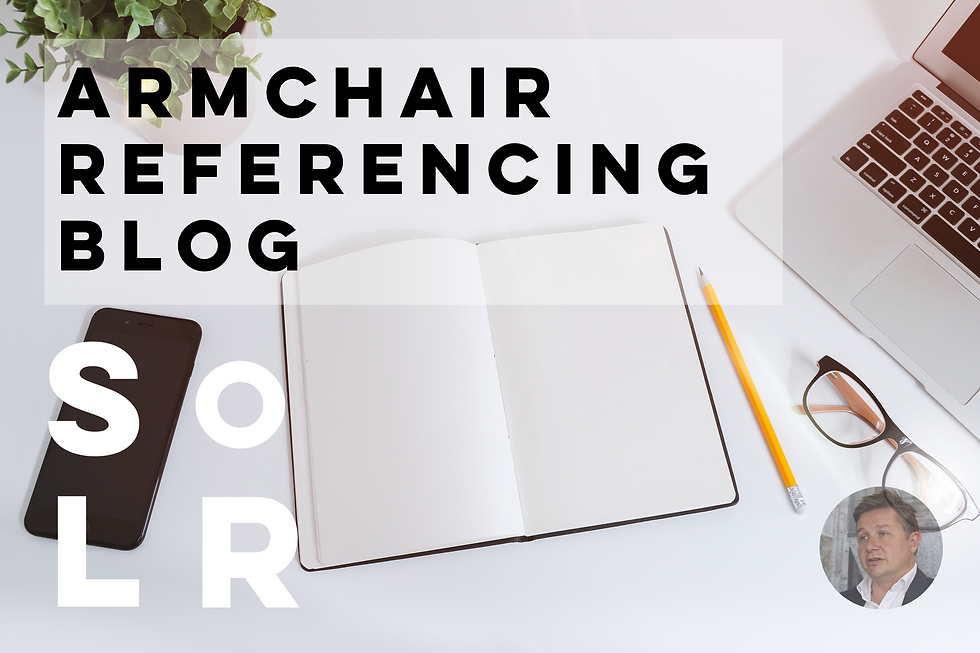Armchair land referencing #11
- Ashley Parry Jones

- Mar 3, 2023
- 4 min read

In the last edition I shared an image of a bridge over the Thames with houseboats moored under it. And, to illustrate how complicated things can be, I asked what interests might be associated with this location.
The river happens to be owned by the Port of London Authority here, not the Crown Estate, the bridge is Battersea Railway Bridge and this structure belongs to Network Rail (although confusingly they call it Chelsea River Bridge in their asset register). It carries the London Overground services operated by TfL and others may also have running rights. The houseboat is privately owned and the owner owns the mooring but needs a license from the PLA to moor there. Each boat at this location leases a berth from a private marina company that operates the pontoon. The boats themselves may or may not be ignored for land referencing purposes (depending on what is proposed to be done with them) as they are moveable and not ‘landed interests’. Complicated! But did you also remember the new underground interests held by Tideway Tunnel? These rights are under the north side of the bridge and are currently temporary rights but will become permanent corridors of ownership (and a little narrower) once the as-built tunnel currently being completed is registered. It is to these often-hidden underground rights we turn our attention in this edition. As always, I give just an overview because subsoil rights are just as complicated as any other rights and would require volumes to explain in forensic detail.
London is a good place to consider underground features. It is regarded as the world capital for tunnelling projects being suitable for tunnelling because of the underlying periglacial clay deposits (recent projects including the Jubilee line extension, Crossrail, Tideway, Crossrail 2 and Silvertown Tunnel which all required books of reference). The first ever tunnel under a navigable river was the Thames Tunnel between Rotherhithe and Wapping (now used, ironically, as part of the London Overground network). There are now at least 33 road, pedestrian, utility, Tube and rail tunnels under the Thames in London. London is so riven with tunnels it even calls its mass transit system ‘the Underground’ even though 55% of the network is above ground). But the Tube isn’t the only underground railway in London. Below is a map showing the route of the 10.5km Post Office Railway that linked Paddington Station with the key London sorting offices from 1927 until its closure in 2003.

London is criss-crossed by lots of forgotten tunnels. I once worked with a chap who had a key to the door under the statue of Boudica next to Westminster Bridge that accessed the service tunnel that runs the length of the Victoria Embankment to Blackfriars Bridge, built by Sir Joseph Bazalgette to take the District line and his new sewers in response the Great Stink of 1858 and now being complemented by the Tideway Tunnel.
Some readers may have joined me for a tour along the route of the now entirely tunnelled River Fleet (taking in a few hostelries along the way…). The Fleet is just one of over 20 rivers that have disappeared from view but still feature somewhere in, or under, the fabric of the capital. There are also canal tunnels, a tramway tunnel (under Kingsway at Holborn), private pedestrian tunnels and even one once used to conduct the condemned at Newgate Gaol to the gallows. There are also subterranean facilities: some are in converted Tube stations like at Brompton Road and Down Street; and there are 30 abandoned deep or subsurface stations on the Underground network. There are also catacombs under some London markets, air raid shelters and War Offices, and even an underground farm in Clapham and a subterranean former rifle range at Blackfriars. The identification of the associated rights and restrictions of underground infrastructure is important. Not only do deep piles and new tunnels need to avoid or accommodate underground features but the rights held must be identified so they receive the appropriate notifications. Issues like the plague pits famously unearthed by Crossrail needed to be properly addressed, including from archaeological and environmental heath perspectives. The old burial grounds affected by Thameslink presented a legal dilemma that once taxed me as we faced the prospect of identifying the relatives of all those interred under the arches at London Bridge and Borough. Just because a right is old and / or out of view doesn’t mean it isn’t important, so next time you are considering what rights there are in land don’t forget there may be hidden ones right under your nose – or feet.
Next time we’ll explore a little of the history of land referencing.
This article is written by Ashley Parry Jones, Director – Planning, WSP. The opinions expressed are those of the author and do not purport to reflect the opinions or views of WSP or SoLR or its members. The information provided does not and is not intended to constitute legal advice and instead is offered for general purposes only. It does not constitute the most up to date legal information. Any links and references provided are for the readers’ convenience only and do not constitute a recommendation of those sources.




Comments